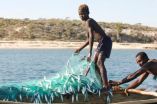(Press-News.org) NEW YORK (February 24, 2012) – A new study by the University of California, Berkeley, Wildlife Conservation Society, and others uses a new scientific methodology for establishing marine protected areas in Madagascar that offers a "diversified portfolio" of management options – from strict no-take zones to areas that would allow fishing.
The methodology looks at existing information on the country's climate, along with dependence on fisheries and marine resources, and applies three different planning approaches to establish priorities for management along the entirety of Madagascar's west coast.
The diversified portfolio approach to marine conservation greatly increases the likelihood of finding and implementing successful management that fits a country's needs while simplifying the process of picking locations and the most appropriate forms of marine management, the authors say.
Considering the need to develop a management regime for the reefs and mangroves of Madagascar that factors in the impacts of climate change, the methodology recommends a range of conservation areas with strict no-take protection as only one type of management recommendation.
The paper appears in the February 16th issue of the open access journal PLoS One. Authors include: Thomas Allnut, Merrill Baker, and Claire Kremen of the University of California, Berkeley; Tim McClanahan, Caleb McClennen, Andry Rakotomanjaka, and Tantely Tianarisoa of the Wildlife Conservation Society; Erwann Lagabrielle and Serge Andrefouet of the Institut de Recherche pour le Développement; and Reg Watson of the University of British Columbia.
The authors say the process provides a more efficient and comprehensive way to plan on a large scale and found that several marine areas in Madagascar come out as conservation priorities across all methodologies. Specifically, these included reefs in the vicinity of the Barren Islands, the large shallow banks to the northwest and southwest, and the reefs of Juan de Nova.
The study highlights the differences in the country's regional patterns. These include heavy human pressure in the south and areas of high climate variability intermixed with lower vulnerability but high biodiversity in the northwest. Areas of particularly high biodiversity value include the islands, reefs, and bays of the northwest; the fringing reefs of the southwest; and the barrier reefs and islands of the central west coast.
Madagascar is one of the poorest countries on Earth yet has proposed to create over 1 million hectares (3,861 square miles) of protected areas to provide for the long-term conservation of its marine resources.
"It behooves countries, in the face of impending fisheries and climate crises, to plan and implement intelligent management that will increase the resilience of their natural marine resources," said co-author Tim McClanahan of the Wildlife Conservation Society, "This paper will provide a roadmap for Madagascar to plan and manage these resources and the methods should prove affordable and useful for the poorest countries where adaptation to climate change will make marine spatial planning a critical part of a successful response."
Co-author Caleb McClennen, WCS Director for Marine Programs, said: "Creation of protected areas is a key conservation strategy to safeguarding marine resources, but one size doesn't fit all. This study demonstrates the need for a comprehensive portfolio of management solutions from community based coastal fisheries to fully protected marine parks."
INFORMATION:
This study has been supported partly by the John D. and Catherine T. MacArthur Foundation. The MacArthur Foundation supports creative people and effective institutions committed to building a more just, verdant, and peaceful world. In addition to selecting the MacArthur Fellows, the Foundation works to defend human rights, advance global conservation and security, make cities better places, and understand how technology is affecting children and society. More information is at www.macfound.org.
The Wildlife Conservation Society saves wildlife and wild places worldwide. We do so through science, global conservation, education and the management of the world's largest system of urban wildlife parks, led by the Flagship Bronx Zoo. Together these activities change attitudes toward nature and help people imagine wildlife and humans living in harmony. WCS is committed to this mission because it is essential to the integrity of life on Earth. Visit: www.wcs.org
Special Note to the Media: If you would like to guide your readers or viewers to a Web link where they can make donations in support of helping save wildlife and wild places, please direct them to wcs.org.
Study IDs new marine protected areas in Madagascar
2012-02-27
ELSE PRESS RELEASES FROM THIS DATE:
Protecting the climate by reducing fluorinated greenhouse gas emissions
2012-02-27
Hydrofluorocarbons (HFCs), which have been used in recent years in increasing quantities as substitutes for CFCs, are also climatically very active and many are also extremely long-lived. In the renowned journal Science an international team of researchers recommends that the most potent of these gases also be regulated. This could save the positive «side effect» of the Montreal Protocol for the global climate.
It is regarded as the most successful international environmental agreement and has, to date, been ratified by 196 countries – the Montreal Protocol on Substances ...
Experts in pediatric heart disease present research at Cardiology 2012 conference
2012-02-27
Pediatric cardiology researchers and clinicians from almost 50 centers from across the U.S. and around the world are gathering at the Cardiology 2012 Conference sponsored by The Children's Hospital of Philadelphia on Feb. 22-26 in Orlando, Fla. The news briefs below summarize 11 research abstracts selected by the conference organizers as featured presentations. The researchers leading these presentations comprise 6 physicians and 5 nurses.
New Early Warning Algorithm Detects Children's Early Cardiac Deterioration Before Inpatient Arrest
Most cardiopulmonary arrests in ...
OAI: Florida Auto Insurance Bill Gets Final Committee's Approval
2012-02-27
A controversial bill that would make big changes to Florida's car insurance coverage system should soon be on its way to a vote by the full House after getting the OK from the third and final committee to review it, according to OnlineAutoInsurance.com.
If the bill is signed into law, drivers who go to run their next Florida insurance quote comparison could be in for a bit of a surprise.
That's because the bill would, among other things, nix the current system in which motorists rely on personal injury protection (PIP) policies to pay for their medical bills following ...
Evolution of earliest horses driven by climate change
2012-02-27
When Sifrhippus sandae, the earliest known horse, first appeared in the forests of North America more than 50 million years ago, it would not have been mistaken for a Clydesdale.
It weighed in at around 12 pounds--and it was destined to get much smaller over the ensuing millennia.
Sifrhippus lived during the Paleocene-Eocene Thermal Maximum (PETM), a 175,000-year interval of time some 56 million years ago in which average global temperatures rose by about 10 degrees Fahrenheit.
The change was caused by the release of vast amounts of carbon into the atmosphere and ...
Green fuel versus black gold
2012-02-27
A life cycle assessment of growing crops for fuel as opposed to refining and using fossil fuels has revealed that substitution of gasoline by bioethanol converted from energy crops has considerable potential for rendering our society more sustainable, according to a Japanese study published in the International Journal of Foresight and Innovation Policy.
Kiyotada Hayashi of the National Agriculture and Food Research Organisation in Tsukuba and colleagues explain how biomass derived from sugarcane, sugar beet and other crops, has emerged as one of the most promising renewable ...
Doctors find new way to predict recurrent stroke
2012-02-27
New research from the University of Calgary's Hotchkiss Brain Institute (HBI) shows that using a CT (computerised tomography) scan, doctors can predict if patients who have had a transient ischemic attack (TIA) or minor stroke, with neurological symptoms such as weakness or speech issues, are at risk for another more severe stroke. This vital information can help doctors decide if stronger medications should be used to prevent future episodes, or if a patient can be safely sent home.
Currently, doctors can use a brain MRI (magnetic resonance imaging) scan to predict ...
How heavy and light isotopes separate in magma
2012-02-27
In the crash-car derby between heavy and light isotopes vying for the coolest spots as magma turns to solid rock, weightier isotopes have an edge, research led by Case Western Reserve University shows.
This tiny detail may offer clues to how igneous rocks form.
As molten rock cools along a gradient, atoms want to move towards the cool end. This happens because hotter atoms move faster than cooler atoms and, therefore, hotter atoms move to the cool region faster than the cooler atoms move to the hot region.
Although all isotopes of the same element want to move towards ...
A biodiversity discovery that was waiting in the wings -- wasp wings, that is
2012-02-27
From spaghetti-like sea anemones to blobby jellyfish to filigreed oak trees, each species in nature is characterized by a unique size and shape. But the evolutionary changes that produce the seemingly limitless diversity of shapes and sizes of organisms on Earth largely remains a mystery. Nevertheless, a better understanding of how cells grow and enable organisms to assume their characteristic sizes and shapes could shed light on diseases that involve cell growth, including cancer and diabetes.
Providing new information about the evolution of the diversity of sizes and ...
In the genes, but which ones?
2012-02-27
For decades, scientists have understood that there is a genetic component to intelligence, but a new Harvard study has found both that most of the genes thought to be linked to intelligence are probably not in fact related to it, and identifying intelligence's specific genetic roots may still be a long way off.
Led by David I. Laibson '88, the Robert I. Goldman Professor of Economics, and Christopher F. Chabris '88, PhD '99, Assistant Professor of Psychology at Union College, a team of researchers examined a dozen genes using large data sets that included both intelligence ...
A million chances to save a life
2012-02-27
PHILADELPHIA -- Would you be able to find an automated external defibrillator if someone's life depended on it? Despite an estimated one million AEDs scattered around the United States, the answer, all too often when people suffer sudden cardiac arrests, is no.
In a Perspective piece published online this week in the journal Circulation: Cardiovascular Quality Outcomes, two researchers from the Perelman School of Medicine at the University of Pennsylvania outline the tremendous potential associated with greater utilization of AEDs in public places and a method to find ...


